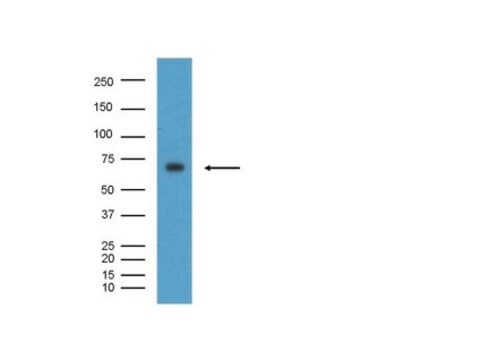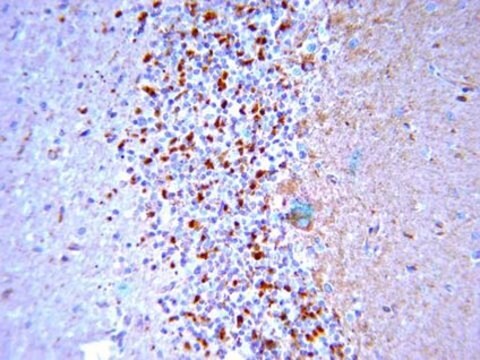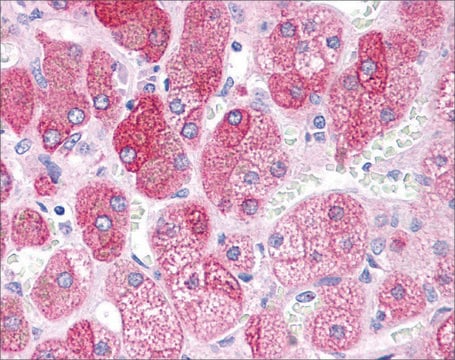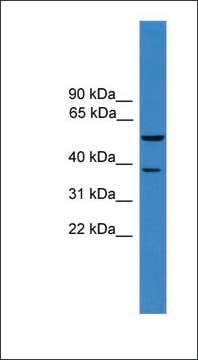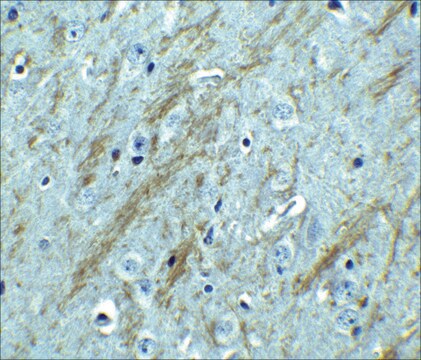추천 제품
생물학적 소스
rabbit
Quality Level
결합
unconjugated
항체 형태
affinity isolated antibody
항체 생산 유형
primary antibodies
클론
polyclonal
양식
buffered aqueous solution
분자량
antigen 70 kDa
종 반응성
human
향상된 검증
recombinant expression
Learn more about Antibody Enhanced Validation
기술
microarray: suitable
western blot: 1:1,000 using a whole cell extract from the human kidney HEK293 cell line stably transfected with human BACE-1
UniProt 수납 번호
배송 상태
dry ice
저장 온도
−20°C
타겟 번역 후 변형
unmodified
유전자 정보
human ... BACE1(23621)
일반 설명
BACE-1 (β-site APP cleaving enzyme, Asp2 or memapsin 2) is known as β-secretase. BACE-1 is highly expressed in neurons, the major site of Aβ generation. BACE-1 is localized within the Golgi and endosomal compartments, among the several intracellular sites where Aβ is thought to be produced. It constitutes the predominant β-secretase activity in human brain tissue.
면역원
synthetic peptide corresponding to the C-terminus of human BACE-1 (amino acids 485-501).
애플리케이션
Anti-BACE 1, C-Terminus (485-501) antibody produced in rabbit has been used in western blotting.
생화학적/생리학적 작용
Overexpression of β-site APP cleaving enzyme (BACE-1) leads to increased β-secretase activity while displaying appropriate cleavage site specificity for amyloid precursor protein (APP).
물리적 형태
Solution in 0.01 M phosphate buffered saline, pH 7.4, containing 1% bovine serum albumin and 15 mM sodium azide.
면책조항
Unless otherwise stated in our catalog or other company documentation accompanying the product(s), our products are intended for research use only and are not to be used for any other purpose, which includes but is not limited to, unauthorized commercial uses, in vitro diagnostic uses, ex vivo or in vivo therapeutic uses or any type of consumption or application to humans or animals.
적합한 제품을 찾을 수 없으신가요?
당사의 제품 선택기 도구.을(를) 시도해 보세요.
Storage Class Code
12 - Non Combustible Liquids
WGK
nwg
Flash Point (°F)
Not applicable
Flash Point (°C)
Not applicable
가장 최신 버전 중 하나를 선택하세요:
Marcus O W Grimm et al.
International journal of molecular sciences, 17(11) (2016-11-02)
One of the characteristics of Alzheimer´s disease (AD) is an increased amyloid load and an enhanced level of reactive oxidative species (ROS). Vitamin E has known beneficial neuroprotective effects, and previously, some studies suggested that vitamin E is associated with
Docosahexaenoic acid reduces amyloid beta production via multiple pleiotropic mechanisms
Grimm MOW, et al.
Test, 286(16), 14028-14039 (2011)
S Prasad Gabbita et al.
PloS one, 10(10), e0137305-e0137305 (2015-10-06)
Cytokines such as TNFα can polarize microglia/macrophages into different neuroinflammatory types. Skewing of the phenotype towards a cytotoxic state is thought to impair phagocytosis and has been described in Alzheimer's Disease (AD). Neuroinflammation can be perpetuated by a cycle of
Marcus O W Grimm et al.
The Journal of biological chemistry, 283(17), 11302-11311 (2008-03-01)
The major molecular risk factor for Alzheimer disease so far identified is the amyloidogenic peptide Abeta(42). In addition, growing evidence suggests a role of cholesterol in Alzheimer disease pathology and Abeta generation. However, the cellular mechanism of lipid-dependent Abeta production
Tatjana L Rothhaar et al.
TheScientificWorldJournal, 2012, 141240-141240 (2012-05-02)
Lipids play an important role as risk or protective factors in Alzheimer's disease (AD). Previously it has been shown that plasmalogens, the major brain phospholipids, are altered in AD. However, it remained unclear whether plasmalogens themselves are able to modulate
자사의 과학자팀은 생명 과학, 재료 과학, 화학 합성, 크로마토그래피, 분석 및 기타 많은 영역을 포함한 모든 과학 분야에 경험이 있습니다..
고객지원팀으로 연락바랍니다.
